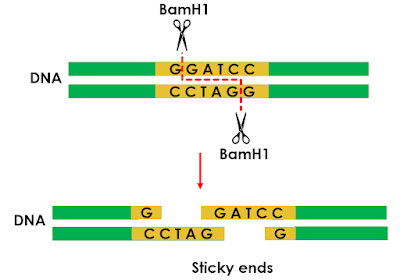Molecular scissors restriction endonucleases
Molecular scissors restriction endonucleases are enzymes that are used to cut DNA at specific sequences, called recognition sites. These enzymes are widely used in molecular biology techniques such as restriction fragment length polymorphism (RFLP), cloning, and genome editing.
Restriction endonucleases are found naturally in bacteria, where they are used as a defense mechanism against invading viral DNA. These enzymes recognize and cut specific sequences within the viral DNA, preventing the virus from replicating and spreading. Scientists have harnessed the power of these enzymes and have been using them in molecular biology research for over half a century.

|
| Action of restriction endonuclease BamHI |
Sticky and blunt ends
A restriction endonuclease cuts DNA at specific sequences called "restriction sites." A restriction site is a specific sequence of DNA to which a restriction enzyme binds and cuts the DNA molecule. Restriction enzymes are endonucleases that cut the phosphodiester bond of the DNA, producing either blunt or sticky ends.
The cut ends of the DNA molecule are known as "sticky ends" or "cohesive ends" because they have short, single-stranded overhangs that can pair with complementary overhangs on another DNA molecule. These overhangs can be used in molecular biology techniques such as DNA ligase to join the two DNA molecules together.
"Blunt ends" refer to the cut ends of a DNA molecule that have no overhangs. They are the opposite of sticky ends and can be joined together using DNA ligase.
Types of molecular scissors restriction endonucleases
Restriction endonucleases are classified into two types: Type I and Type II.
1. Type I restriction endonucleases
Type I restriction endonucleases are complex enzymes that require multiple subunits to function. They recognize and cut DNA at specific sites within the recognition sequence, but the cut is not always precise and can occur at different locations within the recognition sequence.
2. Type II restriction endonucleases
Type II restriction endonucleases, on the other hand, are simpler enzymes that recognize and cut DNA at specific, palindromic sequences. The cut is always precise and occurs at specific locations within the recognition sequence, generating cohesive or "sticky" ends.
Type II restriction endonucleases are the most widely used in molecular biology research. They are simple to use, have a high degree of specificity, and generate specific, reproducible fragment patterns. This makes it easy to identify and isolate specific genes or regions of the genome. Additionally, the recognition sites for these enzymes are usually 4-8 base pairs in length, which means that they occur relatively infrequently in the genome, reducing the chance of cutting a gene or other important sequence.
Examples of Type II restriction endonucleases include EcoRI, which recognizes the sequence "GAATTC" and cuts between the G and A, and PstI, which recognizes the sequence "CTGCAG" and cuts between the C and T.
Video lesson on molecular scissors restriction endonucleases
Applications of molecular scissors restriction endonucleases
Restriction endonucleases are widely used in molecular biology research, and many commercially available enzymes are used in a variety of applications such as DNA sequencing, DNA cloning, and genome editing.
1. DNA cloning
One of the most common applications is the use of restriction endonucleases in the process of DNA cloning. Cloning is the process of creating multiple copies of a specific DNA fragment. By cutting the DNA with restriction endonucleases at specific sites, researchers can isolate a specific fragment of interest and then insert it into a vector, such as a plasmid, to create multiple copies of the fragment. This process is widely used in genetic engineering and biotechnology research.
2. DNA fingerprinting
Restriction endonucleases are also used in DNA fingerprinting and genetic identification. Restriction fragment length polymorphism (RFLP) is a technique that uses restriction endonucleases to cut DNA at specific sites and then compares the resulting fragment patterns to identify individuals or populations. This technique is often used in forensic science and paternity testing.
3. Genome editing
Another important application of restriction endonucleases is in the field of genome editing. The ability to precisely cut DNA at specific locations has revolutionized genetic research by allowing scientists to make specific changes to the genome. This has led to the development of techniques such as CRISPR-Cas9, which uses a specific enzyme to cut DNA at a specific location, allowing researchers to add, delete, or modify specific genes.
Conclusion
In conclusion, restriction endonucleases, also known as molecular scissors, are powerful tools in molecular biology research. They are widely used in applications such as DNA sequencing, DNA cloning, and genome editing. Their ability to cut DNA at specific sites has revolutionized genetic research and has led to many breakthroughs in the field of genetics and biotechnology. The most widely used restriction endonucleases are Type II restriction endonucleases which are simple to use, have a high degree of specificity and generate specific, reproducible fragment patterns.
It's important to note that the recognition sequences of restriction endonucleases are specific to certain organisms, and the availability of restriction endonucleases for certain species may be limited, and it's crucial to check the recognition sequence of the enzyme before use.





0 Comments